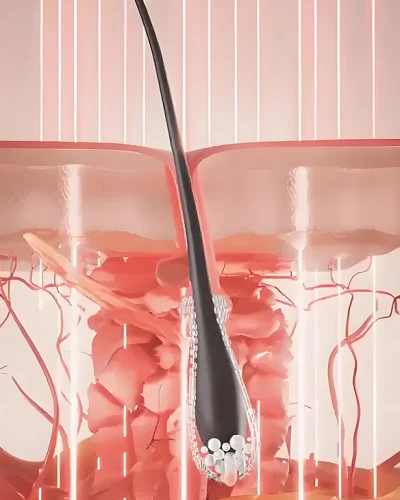Comment la thérapie laser de niveau (Lllt) Favorise la croissance des cheveux
Hair loss is one of the most common concerns today, avec alopécie androgénétique (AGA) being the leading cause. Studies estimate that 60–70% of adults worldwide experience some degree of hair thinning during their lifetime.
Traditional treatments include minoxidil, finasteride, and hair transplantation. While these methods can be effective, they each come with limitations: minoxidil requires lifelong use, finasteride may cause sexual side effects, and hair transplants are costly and invasive.
Au cours des dernières années, Low-Level Laser Therapy (Lllt) has emerged as a promising alternative. Using red light at around 650 nm, this FDA-cleared, non-invasive treatment offers a safe and convenient way to stimulate hair regrowth.
Light and Hair Follicles: Why Can Light “Wake Up” Hair?
Light isn’t just illumination—it can influence cellular activity. This is known as photobiomodulation.
Feu rouge (650 nm): Penetrates the scalp deeply enough to reach the hair follicle’s dermal papilla, which is the “engine” of hair growth.
Lumière bleue (~415 nm): Acts on the skin’s surface, improving scalp health by reducing oil and microbial overgrowth.
En bref, red light fuels follicle regeneration, while blue light cleans up the scalp environment.

How Red Light Stimulates Hair Growth
Boosts Cellular Energy
Red light stimulates mitochondria, leading to increased production of ATP—the energy currency of cells. With more energy, hair follicle cells remain more active.
Prolongs the Growth Phase
Hair grows in cycles: growth (anagen), regression (catagen), and rest (telogen). Red light helps delay the regression phase, keeping hair in “growth mode” longer.
Improves Blood Flow and Microcirculation
By dilating scalp blood vessels, red light enhances oxygen and nutrient delivery to follicles.
Regulates Key Pathways
Activates the Wnt/β-catenin signaling pathway, essential for hair follicle regeneration.
Reduces expression of inflammatory genes, protecting the follicle environment.
The Supporting Role of Blue Light
While red light is the main driver of regrowth, blue light provides complementary benefits:
Oil control: Reduces sebum production, lowering the risk of clogged follicles.
Antibacterial effect: Suppresses harmful microbes such as Cutibactérie acnés, reducing scalp inflammation.
Synergy with red light: Blue light prepares a cleaner scalp environment, while red light stimulates new hair growth.
Scientific Evidence
In vitro studies: Human hair follicles exposed to 650 nm red light showed increased hair shaft length and higher expression of the cell proliferation marker Ki67. Genetic analysis revealed activation of pathways related to metabolism and cell cycle progression.
Animal studies: Mice treated with OLED red light grew hair in areas nearly three times larger compared to controls, with improved scalp blood flow and oxygenation.
Clinical trials: Users of red light helmets or laser combs experienced significant increases in hair density and thickness after 3–6 months of consistent use. Some studies also noted reductions in scalp oiliness and inflammation.
Practical Use and Considerations
Devices: Laser combs, LED helmets, flexible OLED patches.
Key parameters:
Longueur d'onde: 650 nm red light is most proven; some devices also include 830 nm ou 910 nm for deeper penetration.
Energy density: Typically effective in the 0.8–1.6 J/cm² gamme. Too low may be ineffective; too high may suppress growth.
Fréquence: Usually 2–3 times per week, 10–20 minutes par séance.
Safety: Generally well-tolerated, with occasional mild warmth or scalp tingling.
Limitations:
Requires consistency—visible results usually appear after 3–6 months.
Ineffective for follicles that are completely dead.
Individual results vary.
Conclusion
Low-Level Laser Therapy (Lllt) represents a safe, non-invasif, and science-backed option for those struggling with hair loss. While not a “quick fix,” consistent use can lead to thicker, healthier hair over time. With advances in wearable devices and personalized treatment, LLLT may soon become an essential part of hair care and restoration strategies.

